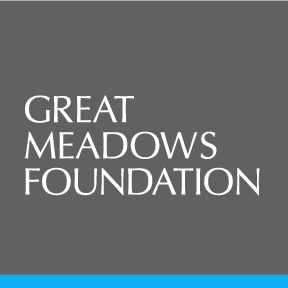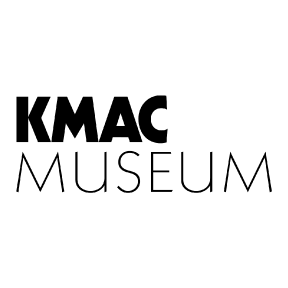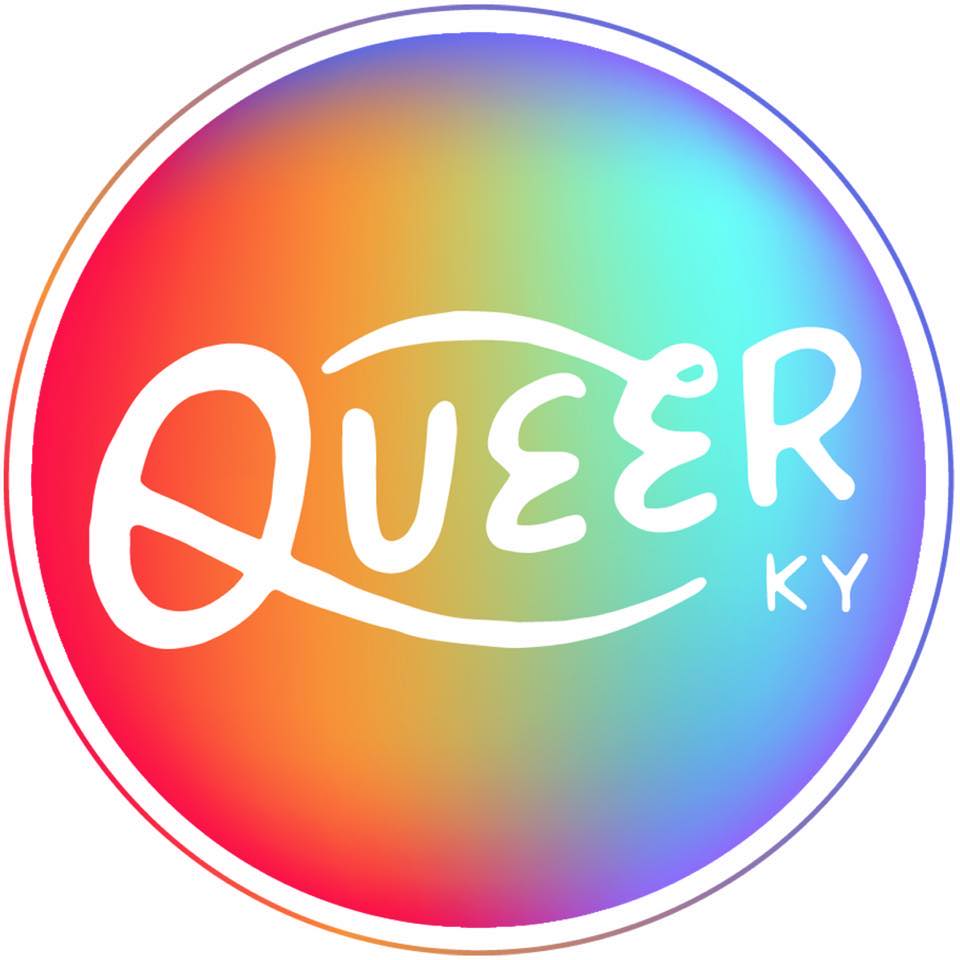
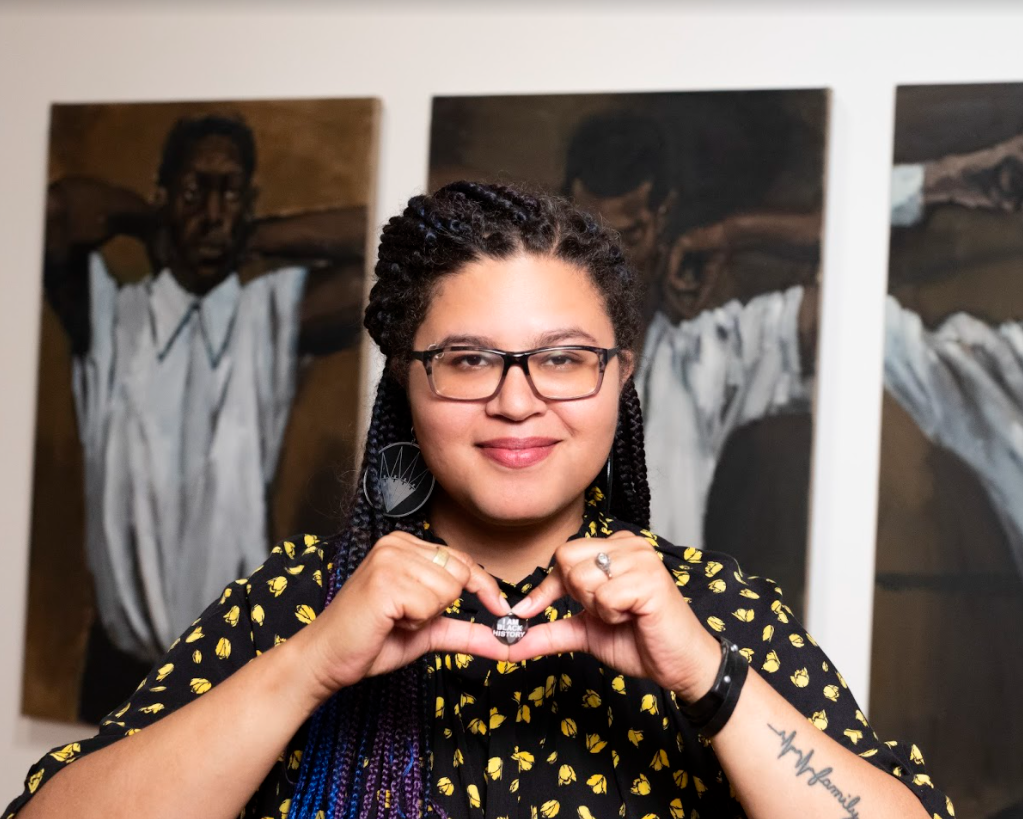
Above: Esther Callahan
Esther Callahan
Q&A
with Kevin Warth
Esther Callahan (she/her) is a Minnesota-based independent curator, arts organizer, and feminist scholar whose practice is rooted in the impact of racial and gender equity. Callahan recently completed her time as the 2021 Great Meadows Foundation Critic-in-Residence. Over the course of two months, she made studio visits with select artists and gave critical attention to the art community in Kentucky. Kevin Warth spoke with Callahan over Zoom to learn more about her perspectives on the Kentucky art community and how her own practice was impacted by this experience.
Kevin Warth: Are you glad to be back in Minnesota now?
Esther Callahan: You know, it's a bittersweet thing; you get this incredible opportunity to be somewhere for two months and really do a deep dive into the communities, the cultures, the art scene, the people, and you finally get your groove. Of course, you're always happy to be home with your pillow in your bed and I'm so happy to see my family, my husband, and friends. Plus, cooking again is great. Because I'm no longer always on the road, we've been cooking non-stop.
KW: To start off, I would love to learn a bit about you and your journey. You have degrees in Gender, Women, and Sexuality Studies and Social Justice Leadership. How did you find your way to the art world?
EC: I actually went to school originally for business and early childhood education. I used to teach preschool and then I was working in a junior high for a few years; I realized that art was always the catalyst that started a conversation or helped somebody to open up. Art was always part of it. I lost my mother at a young age, lost my grandparents at a young age, and lost siblings at a young age. Art was that healing component that I needed. When I wanted to shift out of working in education, I still wanted art to be a component for me. I just started doing everything and anything I could with art. I worked in a nonprofit called Free Arts Minnesota, where I was building a culturally sensitive art curriculum that would be a part of the lives of over 4,000 children around the Twin Cities and surrounding suburbs. That work was really rooted in the importance of getting to know the community, the cultural scene, and how art can be inclusive and integrated into so many different ways of education. It pushed me to want to consider the area of art that I'm most intrigued by. I remember the first time I saw Judy Chicago's work and I was like, “Oh my God, it's feminist art.”
I went back to school to get another degree in Gender, Women, and Sexuality Studies, but it was through a lens of art. To have my own artistic practice and sharing space with so many art communities, at this point it was like art is a part of who I am. It is a part of what I do. I'd been putting together curatorial projects for years, and not really called myself a curator because I didn't take the traditional path of curatorial studies or art history. I was wondering, do I get to call myself that? And then, I realized that, when you've been doing something for 20 years, you are that.
After I graduated again, there was an incredible opportunity at the Minneapolis Institute of Art, the very first arts organization that I had gone to as a child. It was a full circle experience to now be working in the field of contemporary art curation and having been introduced to art in that space. It was really easy to see how art education, diversity, equity, inclusion, and social justice are all linked, and how I could use this spectrum of knowledge and impart it into my curatorial practice.
KW: It’s not an atypical journey by any means, and everyone has their own unique path. How did your experiences inform your perspective as you met with artists throughout Kentucky?
EC: When I started, I spoke with my assistant, the incredible Abigail Briney, and talked about what I was interested in doing. My practice is not rooted in a specific ethnicity, race, or background, but I have not seen as much integration with BIPOC artists as I would like. That's where my practice has been moving. I wanted at least 60% of the artists I met with to be BIPOC. I wanted to know and understand a little bit more about what they're doing. The majority of them ended up being women, which kind of fit into my Gender, Women, and Sexuality Studies background.
I want to point out too that there were a lot of men that maybe don't identify as feminist, but their art is, in my opinion, very much rooted in that intersection. I started with identifying the artists that I want to work with, whose art I'm inspired or intrigued by. Then, I asked: How can I help to provide a platform for them to be seen more and be included in Kentucky’s art scene? And how do I create connections for each of those artists while I'm there?
KW: What do you hope the lasting impact of the critic-in-residence program is?
EC: I don't want to speak for the other critics-in-residence, but we have an opportunity to insert ourselves and create dramatic opportunities for a different read on the city, the state, and the region. There were a number of artists that I met with who did not have an opportunity to become an artist unless they worked full time or until they retired. If that's happening for everyone regardless of the caste system that we have in the United States, we know that there is an incredible opportunity for more artists to be centered and to be seen in every level, in every arena, and with every opportunity.
But how does that happen if there isn't an integrated space that allows for all these different organizations and communities to promote all of the opportunities that are out there? That was something that I noticed quite a lot: there's a group over here doing some stuff. There's a group over there that's doing stuff. Where's that central organization that houses that information and is making sure that it's being disseminated equitably to all areas of the state? Having been in rural and urban areas, you can see that this is everywhere, not just Kentucky, Ohio, Indiana, or Tennessee. It happens right here in Minnesota.
My hope is that we can create broader intersections of different backgrounds and identities represented together, not just this bubble of BIPOC artists that's being pushed right now in the art world, but seeing the art scene in Kentucky as a broad spectrum of possibility and bringing in new and nuanced voices into the spaces that are available. I wish I could say that I've seen every single gallery, every single museum in Ohio, Kentucky, and Indiana, but that is absolutely not possible in two months, especially if I'm trying to build mile deep, inch wide relationships with artists.
KW: What surprised you the most in your time here?
EC: What surprised me the most is the amount of artistic energy being put into work around issues with our planet. There was a lot of eco art. I don't want to put a label on the art for the artists, but that’s an easy way to understand it: art that is rooted in promoting and raising consciousness around the issues that are affecting our planet, whether it's garbage, the use of NFTs that aren't green, the use of technology that is constantly being put into landfills, excessive waste, what's happening with our soil, what's going on with our air, and with our water. It was incredible.
The first meeting I had at Great Meadows was with a bunch of artists. They were introducing themselves and saying what their background is. Everybody's eyes just lit up, because it was like, “Whoa, you do this kind of art too?” It was like a convergence of eco artists was happening there. I'm sitting there and curating a show in my head; it wouldn’t even be hard because they are incredible artists with incredible, thoughtful works in process that are rooted in incredible creativity, but also remind us that we live in a space that we have to care for.
KW: What do you think it is about Kentucky that is inspiring artists to think through these ideas in their practices?
EC: That's a really good question that I'm still trying to answer. It is a beautiful, agricultural region. Because you have people who are rooted to the soil, to that place, there is an inherent protection of that space. And the protection doesn't have to come from a government entity, it doesn't have to come from activists. Art is its own activism.
I'm not gonna lie, Kentucky was on my radar of places to visit. Now I'm telling everybody, “Why haven't you visited Kentucky yet? It is a really stunning, beautiful state.” I think the people that live there understand how beautiful it is, and I'm not mad at people in Kentucky for not wanting to blow it up so that everybody inundates it. I've had the pleasure of being able to literally go from one end to the other and really get a chance to visit and just see the vast beauty. So I understand the inspiration, I really do get it.
KW: From your perspective in meeting with artists both rural and urban, are there any ways that the artists here can grow and learn?
EC: It goes back to integration again. From my perspective, the biggest problem is not seeing how many more opportunities there are to connect. Organizations can help build and change the arts movement all across the state of Kentucky. There are so many incredible artists there and they just need to find a hub.
KW: I think all the time about this young artist who reached out to Ruckus; she is from a rural part of the state and, in her town and the surrounding area, there was nowhere for her to show and no community for her to tap into. In her email, she said, “As far as I'm concerned, there is no Kentucky art community.” I was so heartbroken to hear that.
EC: It's important to understand the art scene on a spectrum, because your version of an art scene might be different from somebody else's. If I'm a high brow collector, I know all of the galleries that are doing the majority of exhibitions, I know all of the museum curators and executive directors. It's not comparable to a rural artist that's just looking for community. Obviously, it's much easier to build connections with people when you live closer. That's why we have this incredible opportunity right now; since this pandemic began, we've had to connect virtually and there's an opportunity right now for rural and urban connections to happen.
There's great opportunities for organizations that are in Louisville and have programs that invite you into rural spaces and vice versa. There's a lot there that can be tapped into, but again, how do people get that information? Where is that information disseminated? Is it equitably done? We find and work in our niche, but it's within that niche that we each have to figure out what's missing. How can we look more holistically across the art scene in Kentucky and say, “Hey, we really have a handle on this. You really have a handle on this. How do we partner to build connections so that the people that need some support in this area are now being connected?”
It can feel like you never see anyone unless they're in your studio. I remember visiting an artist at Mellwood and I asked, “How many other artists do you know? Do you have open studios where you're getting to know each other or do you only know the artists that are in your vicinity? How often are you intersecting with other artists and building those connections?” Every single artist is getting information from somebody they know, like here's a grant, here's an opportunity. Maybe it doesn't work for them, but they know it could work for you and they can pass it on to you.
KW: You mentioned the possibilities the internet created for artists to connect online. I'd like to zoom out for a moment and think about the relationship between artists and curators. Between the pandemic and the racial justice movement, there's been a real paradigm shift; have you noticed any changes in the ways that curators and artists are engaging with one another?
EC: I know for sure that I've had a shift. I was doing a workshop for Louisville Visual Art on studio visits and there were some questions like, “How do we reach out to a curator?” Now there is even more of an opportunity to reach out: send an email, follow them on social media. These platforms didn't exist a couple of decades ago, so we have this opportunity to shape this art world and our connections in a different and nuanced way that pushes us to vastly redefine how we connect. You don't have to meet somebody at an exhibition opening and have that formal introduction. You can reach out now and just say, “I've been following you on social media and I'm intrigued by your work and I'd love to know if you'd be willing to have a conversation with me.” In a virtual space, we have an opportunity that can expand the curatorial ecosystem. The connections between artists and curators can be so much more expansive than it has been, and there's a push right now for some of the rising curatorial voices, emerging talent, and under-recognized artists.
People have been doing phone calls and virtual studio visits for as long as that opportunity has been around, it's now just become a more accepted form. I will say it is sometimes a little harder to make those connections virtually; you can't see everything as clearly, the lighting might not be great, the internet connection might not be great. But artists don't have to worry about whether or not they have to clean their whole space and have food, so it can remove some of those formal structures of connecting. I'm very much here for that because we need to break down some of these walls of who has access and who deserves to be in these spaces. We need to do a lot more work on interpersonal relationships in the curatorial field to allow people to come in and to remove some of the bureaucracy within it.
KW: Are there ways that the curator/artist relationship can become more equitable? And how do you hope it continues to change and shift?
EC: I think it's a personal journey. I hope that every curator, whether you're independent or working in an institution, works with the guiding principles of diversity, equity, accessibility, and inclusion. I think of this more specifically in my work as an opportunity for consciousness raising as a curator of color. I am always sitting in that code switch moment; I am Black sitting in my Black identity, but I'm in a lot of predominantly white spaces. So I code switch a lot to make sure that those that are in that space understand and I have to shift the way I approach something to fit into the status quo.
What I would really love is for all curators to have guiding principles on DEAI and how to be more inclusive towards the cultural perspective of the artists that they're exhibiting - do the work to understand the cultural context so that you figure out ways to avoid harm. Say I want to do an exhibition on suminagashi,¹ I may have the basic understanding of the art practice but I may not know the cultural context of it. If I co-create with another curator that does have that context, then there is an opportunity to create a more equitable and valuable opportunity. It's a more holistic way of presenting an exhibition that really goes to bat for the cultural component that I believe is so much more necessary than what our world is pushing and asking for.
Also, we have all these opportunities with social media and it's great that curators have an opportunity to share and showcase artists even if they're not working with them on an exhibition. It invigorates me to think about where we can go.
KW: You’ve undoubtedly impacted the careers of the artists you met with, but how has your experience as the critic-in-residence altered your own thoughts or perspectives?
EC: I don't know that I have an answer for that yet. I've been writing daily about it, trying to just wrap my head around this incredible experience. One thing I can acknowledge is that it pushed me to organize in a different way, because it wasn't in a space that I knew. Because I didn't have an opportunity to meet with every artist that I wanted to, to see everything that I wanted to, I had to organize opportunities to gather people in a way that I haven't necessarily done in my practice here in Minnesota. For example, I asked all of the BIPOC artists that I worked with and had studio visits with to introduce me to one to three other artists that may not have been on my radar. I want to push curatorial exhibitions to not just be what's on the wall, but how they can intersect with sound, performance, et cetera. That was new and interesting for me, as it pushed me to think: “How do I engage the artists that I already know, how do I engage artists that are within their community, and then how do we bring all of that together?” On a deeper level, we can form a vision of real collaboration between artistic practices that can result in either furthering a career, introducing someone to a new space, or providing an opportunity to diversify the way that artists think around their practice. My goal wasn't just to invite artists into a specific curatorial space, but about removing some of those walls and really carving out a space and making a platform for these BIPOC artists.
My hope was that we would get together, we'd have a conversation, and we'd build some connections. Well, this group of artists went from 15 to 30, and now they're having regular meetings together and building a collective on how to continue to diversify the art scene in Kentucky. During my time there, I realized that I have a platform. I can use my platform to help create an opportunity, and then hopefully it will be recognized as one of value and continued. When I see these emails going back and forth between all these artists about the things that they're going to do, an opportunity that they found out about, or the feverish writing I saw during that meeting, it brings me so much joy. If anything, Great Meadows Foundation, Al Shands, may he rest in peace, and the work of Executive Director, Julien Robson really gave me an opportunity to create a platform for not only BIPOC artists, but artists that have in many ways been under-recognized.
-
Notes:
- Suminagashi 墨 流 し or “floating ink” is the process of marbling plain paper with water and ink, originating in Japan as early as the 12th century. Definition from https://suminagashi.com/
-
12.8.21
Kevin Warth (he/him) is a Louisville-based artist and art historian whose research emphasizes queer identity, alternate temporalities, and hauntology.
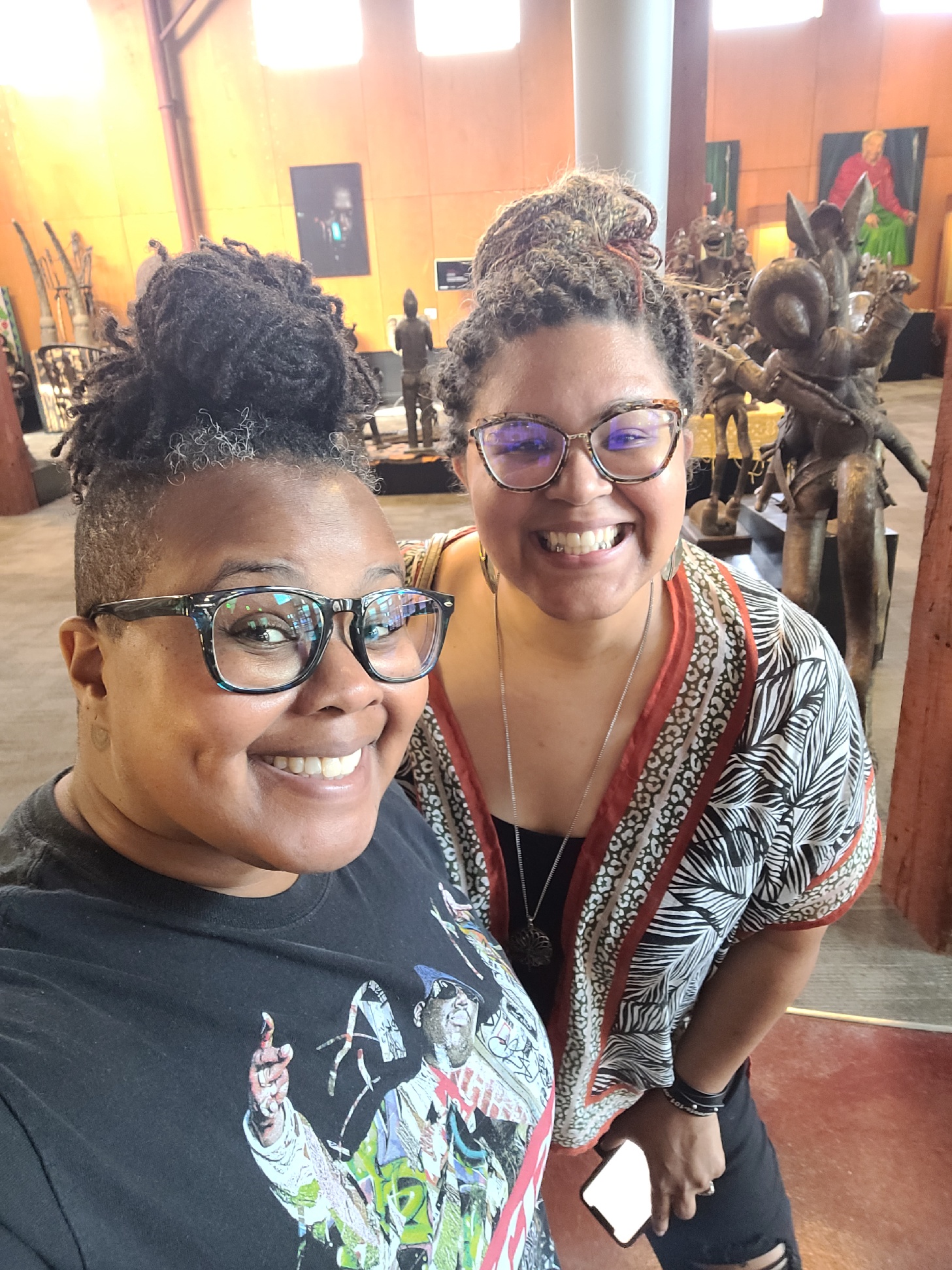
Pictured with artist Christa Harris.
![A selfie with Esther Callahan Tomisha Lovely-Allen and Sandra Charles in front of a wall with paintings in a variety of shapes and sizes.]()
Pictured with artists Tomisha Lovely-Allen and Sandra Charles at Mellwood Art Studios.
![Esther Callahan in front of a painting canvas hung such that it drapes on the wall.]()
Callahan in front of Sam Gilliam's Carousel ii at The Speed Art Museum.

Pictured with artists Tomisha Lovely-Allen and Sandra Charles at Mellwood Art Studios.

Callahan in front of Sam Gilliam's Carousel ii at The Speed Art Museum.



